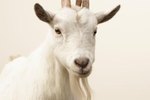Goats have a very specific breeding cycle, which begins at puberty and continues as the does -- female goats -- go into heat, mate with bucks -- male goats -- and reproduce. The breeding cycle culminates in a kid -- a baby goat. Goat breeding cycles follow a regular, careful schedule.
Schedule
Goats are seasonally polyestrous, which means female goats can only breed with males during the fall. This schedule ensures that the does give birth during the season -- four to five months later -- when environmental conditions are optimal for kid survival. This seasonality is primarily affected by day length, as well as temperature and rainfall, and breeding seasons vary by location -- the exception being tropical goats, who are largely unaffected by seasonal variations. In the northern hemisphere, the breeding season ranges from August to January, with kids being born in late winter or spring.
Mating
Female goats can begin to be bred when they weigh around 60 lbs. -- typically reached when they are between 7 and 10 months old. Male goats reach puberty between 4 and 8 months and can also be bred between 8 and 10 months old. One buck can breed anywhere from 20 to 30 does. Female goats go into heat -- meaning they will accept the buck for copulation -- numerous times throughout the mating season. Goat heat, or estrus, comes in cycles; estrus lasts for 24 to 48 hours, and if the doe fails to conceive during this time, estrus will occur again 18 to 21 days later.
Gestation
Once the female goat conceives, gestation lasts 145 to 155 days, a four to five month period which leads to birth during late winter or early spring. The hormone progesterone, which sustains the pregnancy, is produced in the doe by the corpus luteum -- a structure on the goat's ovary. Stress can interfere with the corpus luteum, leading to miscarriage of the pregnancy; common doe stressors include being harassed by dogs, proximity to strange animals or poor nutrition. During the final month of pregnancy, the doe should receive increased crude protein and decreased calcium to prevent milk fever following the birth.
Kids
Female goats produce colostrum, which contains antibodies, vitamins and minerals that are important to kid nutrition. The antibodies in colostrum protect the kids from infection -- including infection that can be created from its mother's dirty teats. Kids born in late winter and early spring will be strongest due to prime grazing conditions. The breeding cycle begins again as kids begin to mount other kids at just 7 days old -- and male and female goats should be separated beginning around 3 months old.
References
- Goat Source; A Beginner's Guide to Breeding Your Goat; Leslie A. Applegate; October 2005
- NC State University; Breeding and Kidding Management in the Goat Herd; J-M. Luginbuhl et al.; October 1998
- Australian Cashmere Growers Association; Reproductive Cycle of Goats; Rob Kelly
- Tennessee Meat Goats; Behavioral and Mating Habits of Goats; Suzanne Gasparotto
- Goat Biology: Goat Gestation Calculator
Photo Credits
-
Jupiterimages/Photos.com/Getty Images
Writer Bio
Based in northern Virginia, Rebecca Rogge has been writing since 2005. She holds a bachelor's degree in journalism from Patrick Henry College and has experience in teaching, cleaning and home decor. Her articles reflect expertise in legal topics and a focus on education and home management.




